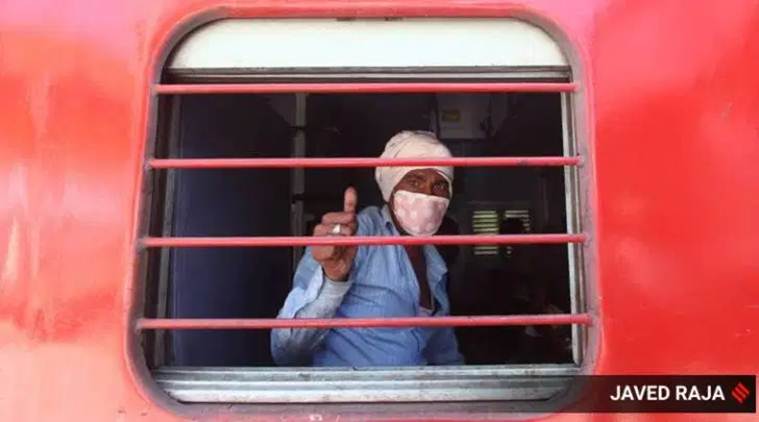 Not waiting for just Shramik Specials, stranded migrants have been taking regular trains too out of big cities to get home since the government restarted 100 pairs of popular long-distance passenger services on May 12. (Representational)
Not waiting for just Shramik Specials, stranded migrants have been taking regular trains too out of big cities to get home since the government restarted 100 pairs of popular long-distance passenger services on May 12. (Representational)
Reflecting the long haul as the government attempts to restart operations in major industrial centres, an analysis of Railway ticket booking patterns shows that unlike trains carrying migrants away from cities, those headed back are largely running with poor ridership numbers.
For example, while a train from Bandra in Mumbai to Ghazipur City in Uttar Pradesh this week was booked to over 130%, trains coming to Mumbai from Gorakhpur (UP), Howrah (West Bengal), Darbhanga (Bihar), Patna and Jaipur have seen an average of 30% seats filled.
Similarly, while a special train from Pune to Danapur (Patna) this week saw over 110% occupancy; on the return journey, it was just 39% full.
Not waiting for just Shramik Specials, stranded migrants have been taking regular trains too out of big cities to get home since the government restarted 100 pairs of popular long-distance passenger services on May 12. These trains leaving big cities like Mumbai, Delhi, Bengaluru and Ahmedabad, for states such as Bihar, Uttar Pradesh and West Bengal, are seeing long waiting times for confirmed berths.
An analysis of the IRCTC data by The Indian Express this week shows that while a special train from Bikaner to Howrah ran with as high as 151% occupancy, Delhi to Dibrugarh (Assam) Brahmaputra Mail ran with 140% occupancy, and trains from Ahmedabad to Howrah and Darbhanga with over 130%.
The Shramik Specials have so far ferried around 60 lakh migrants.
On the daily train from Varanasi to Mumbai’s Chhatrapati Shivaji Maharaj Terminus, a confirmed ticket is available from Thursday. But to get a confirmed ticket on the train leaving CSMT for Varanasi every day, one has to wait for as long as July 16.
The train from Surat to Patna is full till July 13, but the reverse train has tickets available Sunday onwards. The reservation against cancellation tickets are available from the end of this week.
For a ticket on the Rajdhani-like train leaving Delhi every day for Patna, one has to wait till June 23. But, for the same train coming from Patna to Delhi, confirmed tickets are available Wednesday onwards.
The Sampoorna Kranti Express from Delhi to Patna has a waiting list for the next one month, whereas for way back, confirmed tickets are available from next week.
On the Duronto Express leaving Bengaluru for Howrah, a sleeper class ticket is available only after July 31. But confirmed tickets are available on the special train from Howrah to Bengaluru running five days a week.
Officials said that the 100 pairs of trains and 15 pairs of Rajdhani-like services were the first selected for restart post the lockdown because traditionally these are high-demand trains with waiting lists running into hundreds.
Officials said the trend of filled seats only one way was even more pronounced last month, adding that they expect trains coming back to industrial centres and big cities to start picking up gradually.
They also noted that instances of trains going into big cities with high occupancy are not consistent yet, though there are examples like the Varanasi-Mumbai train on Monday that ran full – though, even at 100% occupancy, the demand is sub-optimal for this sector. While other trains too have seen some good days — Paschim Express from Kalka (Haryana) to Mumbai ran with 83% occupancy one day, and special trains from Howrah and Pune to Ahmedabad more than 100% full this week — officials admitted that this is far from the new normal.
The IRCTC data also shows that many of these trains have poor occupancy in both the directions.
A senior Railway Board member, requesting anonymity, said: “The demand to go back to work will start coming in slowly. Running the trains is part of infusing confidence for return to normalcy.”
Another pattern that is being noted is that people are not planning advance journeys, with berths vacant beyond a few days, despite bookings being taken up to four months.
Officials said the unpredictable and varied quarantine rules in different states may also be discouraging people from undertaking travel.